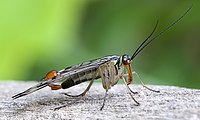
Photo from wikipedia
Gregarine apicomplexans are unicellular organisms that infect invertebrate hosts in marine, freshwater and terrestrial habitats. The largest group of invertebrates infested on land is the insects. The insect order Psocoptera… Click to show full abstract
Gregarine apicomplexans are unicellular organisms that infect invertebrate hosts in marine, freshwater and terrestrial habitats. The largest group of invertebrates infested on land is the insects. The insect order Psocoptera (booklice) has recently gained wider interest due to specimens occurring in stored food products and therefore being considered pest organisms. Biological control agents are often used to eliminate pest organisms. In this study we examined the psocid Dorypteryx domestica, an invasive psocid species that is spreading all over the world. We were able to isolate and describe a new gregarine species (Enterocystis dorypterygis sp. n.) infecting D. domestica. The trophozoites are panduri- or pyriform and their association/syzygy is caudo-frontal. The surface is inscribed by longitudinal epicytic folds covering the complete cell. Phylogenetic analyses of the SSU rDNA gene revealed an only weakly supported relationship with two Gregarina species G. ormieri and G. basiconstrictonea, both from tenebrionid beetles. Gregarines have been proposed to have some potential as biological control agents for several insects. Identifying the gregarine species infecting pest organisms like psocids is a first step and prerequisite for the probable utilization of these parasites as biological control agents in the future.
Journal Title: European journal of protistology
Year Published: 2017
Link to full text (if available)
Share on Social Media: Sign Up to like & get
recommendations!